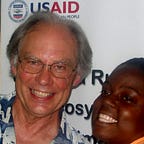Does the rise of mixed martial arts parallel America’s drift toward barbarity?
Many years ago, I stumbled on a craft market in Washington, D.C. At one booth an artist sold small oil paintings laced with social commentary. Most I could figure out, but one had me stumped. The painting portrayed two very pregnant women in shorts and singlets in a boxing ring. One of the women was flat on her back, the other resting a foot on her opponent’s swollen abdomen, her boxing gloves held high over her head in victory.
The artist was happy to explain. “Don’t you think two pregnant women boxers would be a big TV hit?” he grinned. “Is there any moral stop to what Americans would consume as entertainment? Man, it would make millions as a pay-per-view.”
The sardonic brutality of the painting stayed with me, and a few years later I was reminded of the incident when a promoter was denied a license to present an Ultimate Fighting Championship card at a nearby arena. At that time, UFC occupied the same “sports” underbelly as dog fights and cock fighting, featuring bouts of such brutality that matches were relegated to basement gyms and private fight clubs where ringside patrons didn’t wear white shirts for fear of bloodstains.
The UFC tag line of the era said it all: “There are no rules.” Kicking, strangling, holds designed to break bones, eye gouging, pounding an opponent’s face into the canvas until it was a bloody pulp — no holds were barred. Ultimate Fighting was so brutal there was talk of outlawing it.
But ticket sales remained strong, and the UFC promoters knew they were onto a good thing: Violence wasn’t the problem; it was the product. What they had was an image issue.
Marketing consultants were called in, a few rules were introduced, and a new, more palatable sport was created: Mixed Martial Arts. Buffed and sanitized, MMA climbed out of the shadows and into major entertainment venues in casinos and small arenas across America. And then came the TV contracts.
The promoters knew their clientele. All the viciousness of the old UFC remained, but it was legitimatized now, and America ate it up. MMA quickly surpassed boxing in popularity.
Ultimate Fighting had been the trial balloon. How much violence would Americans tolerate in their entertainment? More to the point, how much blood would they pay to see? In an America already desensitized by gun violence and energized by displaced anger, the MMA was the right theatre for the right nation at the right time.
Fast forward 10 years. I take my wife, daughter and her 18-month old baby to a popular restaurant in my wife’s hometown. We sit at a table with a lovely view of the AuSable River, but soon my eyes wander to the mammoth screen at the front of the restaurant.
Two young women in shorts and bras circle each other, each throwing the occasional punch, a kick to the head or kidney. Blood trickles from the nostril of one of the fighters. Then the girl in the black shorts lands a roundhouse kick to the head, and her opponent crashes heavily to the canvas. She leaps on the back of the downed girl and smashes her right fist into the side of the other girl’s head, over and over. Finally, the referee pulls her off. She bounces to her feet and raises her arms in triumph.
I look around the crowded restaurant. Most people are paying no attention even though this violence is being played out on a giant screen a few meters from where they are eating. Some glance up with indifferent detachment. A seven-year-old girl studies the TV silently.
I wonder: If we have become so inured to violence and pain that watching two young women smash each other in the mouth while we eat causes not a ripple of comment, can we expect outrage at the sight of families being ripped apart? Of children dying from lack of health care? Of demagogues calling refugees animals?
When I remark on all of this, my wife offers to change seats so I can’t see the screen. Just don’t look, she says. Dad, don’t pay attention, my daughter tells me.
No one wants to spoil dinner.
